I taught English in Japan for a couple of years, so I felt a certain sense of nostalgia on arriving in Tokyo. The smell of food cooking and frying, the humidity and feeling of the air, the orderliness of everything, the sounds of announcements: all of these things are barely perceptible in everyday life, but they hit you like a wall of familiarity when you return.
One thing that wasn't familiar was the train employee stationed next to the ticket machine at Narita, who spoke English and was there to help people buy their tickets. In my time in Tokyo I would come to see that a lot more people seem to speak English than they do in more rural Japan or the Kansai region (Kobe, Osaka, Kyoto, and environs). I bought the cheapest ticket from Narita to Asakusa, where my hostel was. This involved changing trains and taking the regular commuter line, but only cost ¥1,200 as opposed to the ¥2,500 or so that it would have cost to take the express train.
I arrived in Asakusa at around 10:00 pm. I usually don't have much jet lag when I travel, in either direction, because I can sleep on planes and my sleep schedule is often unsettled. I ended up waking up at around 4:00 in the morning, however, and decided that this would provide a good opportunity to visit the renowned Tsukiji fish market.
Although I had lived in Japan before, I didn't actually see all that much of Japan when I lived there, as the cost of transportation is too high to travel very far during the weekends (a Shinkansen trip from Osaka to Tokyo is about $150 each way); most of my experience in Tokyo comes from when I visited the country in 1993 with my grandmother. And in 1993 I didn't visit Tsukiji—even though I had wanted to—because as a teenager I felt that I would be out of place and in the way during the commercial auctions that Tsukiji is famous for. Ugly Western tourists who really have interfered with both the auctions and the wholesale have resulted in the current situation: in order to see the Tuna auctions you have to queue up and get tickets for a tour, and you can't visit the wholesale market before 9:00, when most business has already been conducted.
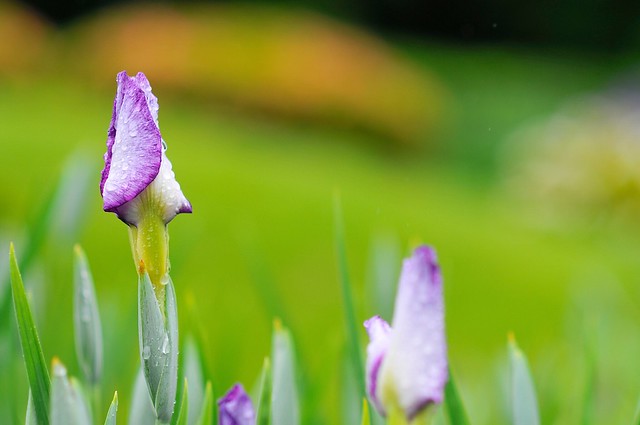
Contrary to his reputation, however, I found him (and his wife) friendly and talkative. I'm not a huge espresso drinker so I started with a cappuccino, which was really good: his coffee lived up to the hype of being sweet and chocolatey.
We talked while he was making my coffee, and I asked him what he thought the best coffee shop in NYC was. He said that he couldn't say, because he thought that there was too much flux in the NYC coffee market, and that was the best one months might not be in a few months. He said he thought he would only be comfortable saying what was best if it had been no more than three months since he drank there, and since he hadn't been in New York in a while he couldn't make a real recommendation.
He then told me about his espresso machine and how it had been recently overhauled by a La Marzocco technician from Italy. After the work, Katsu said something just wasn't right about the shots he was pulling from it, and he eventually tracked down the problem: one of the little steel elbows had originally been a 0.7mm piece, but it had been replaced with a 0.9mm piece. He said even the Marzocco tech thought he was a little crazy, but when the part was replaced the shots returned to their original quality.
A half hour later, well after 2:30, I ordered a Gibraltar. I suspect that his supposed 2:00 rule is not so much because of anything related to electricity, but is actually related to how many shots he believes he can accurately pull each day before his quality starts to slip: by 2:00 his quality has usually dropped below what he considers acceptable.
Anyway, given how sweet his coffee is, I decided to get my Gibraltar without sugar. This is unusual, as I'm known for liking my coffee rather sweet, but the drink was perfect without any sugar.
I ended my stay there by buying some "Flower Child" espresso beans to send to a coffee-loving friend in Bangkok. The review was glowing, saying it was possibly the best espresso he had ever had, and that even his test shots he uses to dial in how to pull a coffee were drinkable with Flower Child, even though he usually just pours them down the drain.
Given Katsu's total control over the coffee-making process (his wife handles the money), I was surprised to learn that there is a second location, Bear Pond No. 8. Apparently they don't make Katsu's signature drinks or unadulterated espressos, which makes some sense.
Harajuku, as Gwen Stefani knows, is where all the cool and fashion-forward kids hang out. On the weekends you get a lot of them showing off their costumes in Yoyogi Park, which is just across the railway tracks to the west. I was there on a Friday, so the only fashion you saw was from people shopping in Harajuku. In contrast to the way it was in 1993, Harajuku was much more mainstream, with some chain stores and even an Audi dealer in the neighborhood—it didn't feel nearly as rebellious as it was before.
One thing that wasn't familiar was the train employee stationed next to the ticket machine at Narita, who spoke English and was there to help people buy their tickets. In my time in Tokyo I would come to see that a lot more people seem to speak English than they do in more rural Japan or the Kansai region (Kobe, Osaka, Kyoto, and environs). I bought the cheapest ticket from Narita to Asakusa, where my hostel was. This involved changing trains and taking the regular commuter line, but only cost ¥1,200 as opposed to the ¥2,500 or so that it would have cost to take the express train.
I arrived in Asakusa at around 10:00 pm. I usually don't have much jet lag when I travel, in either direction, because I can sleep on planes and my sleep schedule is often unsettled. I ended up waking up at around 4:00 in the morning, however, and decided that this would provide a good opportunity to visit the renowned Tsukiji fish market.
Although I had lived in Japan before, I didn't actually see all that much of Japan when I lived there, as the cost of transportation is too high to travel very far during the weekends (a Shinkansen trip from Osaka to Tokyo is about $150 each way); most of my experience in Tokyo comes from when I visited the country in 1993 with my grandmother. And in 1993 I didn't visit Tsukiji—even though I had wanted to—because as a teenager I felt that I would be out of place and in the way during the commercial auctions that Tsukiji is famous for. Ugly Western tourists who really have interfered with both the auctions and the wholesale have resulted in the current situation: in order to see the Tuna auctions you have to queue up and get tickets for a tour, and you can't visit the wholesale market before 9:00, when most business has already been conducted.
Tsukiji to Setagaya
I arrived at Tsukiji to find out that it was closed (I should have checked the schedule, I guess). I wouldn't have been there early enough to take the tour, anyway, but I couldn't even see the market. Instead I wandered around the area for a little, stopped at a nearby 7-Eleven to get some of the snack foods I had missed (there are some great Pizza chips in Japan), then headed to a nearby Yoshinoya for a similarly missed beef bowl.
I then decided to head to the Imperial Palace. It was really surprising how well I remembered it, despite it being almost 20 years since I had been there. I often knew where things should be, and what I would see around the corner. It was kind of eerie at times.
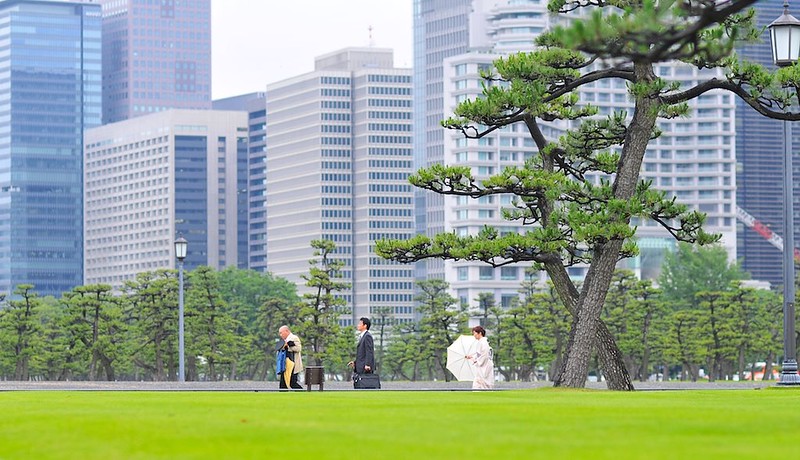 |
Palace grounds.
|
 |
This is Japan.
|
 |
The Palace and moat.
|

 |
Irises flowering in the palace gardens.
|
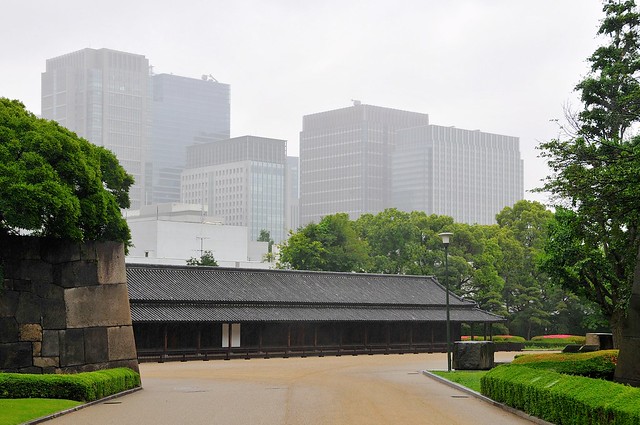 |
Old & new.
|
I decided to walk to the Chinese Embassy to see if I could get a visa (I hadn't had the time to get one back home), and then to Bear Pond Espresso, which was reputed to possibly be the best coffee shop in the world.
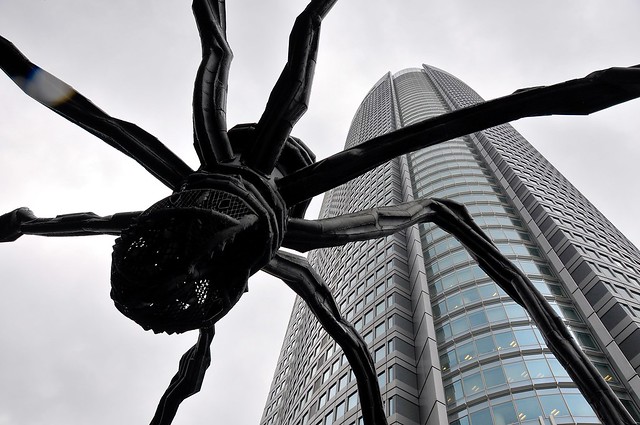 |
Maman sculpture (also seen at the Guggenheim Bilbao) at Roppongi Hills, near the Chinese Embassy.
|
The Chinese Embassy was extremely busy, they only accepted applications until noon, and it would take a week to process a visa. More problematically, they only seemed to be taking applications from people who actually lived in Japan (they wanted a Japanese address), and since I really didn't want to stay in Tokyo for that long, I decided to skip it and apply for the visa in Korea.
Bear Pond Espresso was a fair ways away, and I had heard they only served espresso until 2:00 pm, so I started to walk. Shibuya was on the way, so I did a little window shopping in some of the stores there.
 |
Shibuya Station. Japanese cities can appear very grim.
|
Bear Pond Espresso, Setagaya
Bear Pond is run by a Japanese couple who lived in New York for almost 20 years, and who opened an espresso shop when they returned. The barista, Katsu, has a reputation of being the coffee equivalent of the soup nazi, and according to what you may have read he doesn't make espresso after 2:00 pm. I arrived within a few minutes of 2:00 pm, which had me pretty nervous.Contrary to his reputation, however, I found him (and his wife) friendly and talkative. I'm not a huge espresso drinker so I started with a cappuccino, which was really good: his coffee lived up to the hype of being sweet and chocolatey.
We talked while he was making my coffee, and I asked him what he thought the best coffee shop in NYC was. He said that he couldn't say, because he thought that there was too much flux in the NYC coffee market, and that was the best one months might not be in a few months. He said he thought he would only be comfortable saying what was best if it had been no more than three months since he drank there, and since he hadn't been in New York in a while he couldn't make a real recommendation.
He then told me about his espresso machine and how it had been recently overhauled by a La Marzocco technician from Italy. After the work, Katsu said something just wasn't right about the shots he was pulling from it, and he eventually tracked down the problem: one of the little steel elbows had originally been a 0.7mm piece, but it had been replaced with a 0.9mm piece. He said even the Marzocco tech thought he was a little crazy, but when the part was replaced the shots returned to their original quality.
A half hour later, well after 2:30, I ordered a Gibraltar. I suspect that his supposed 2:00 rule is not so much because of anything related to electricity, but is actually related to how many shots he believes he can accurately pull each day before his quality starts to slip: by 2:00 his quality has usually dropped below what he considers acceptable.
Anyway, given how sweet his coffee is, I decided to get my Gibraltar without sugar. This is unusual, as I'm known for liking my coffee rather sweet, but the drink was perfect without any sugar.
I ended my stay there by buying some "Flower Child" espresso beans to send to a coffee-loving friend in Bangkok. The review was glowing, saying it was possibly the best espresso he had ever had, and that even his test shots he uses to dial in how to pull a coffee were drinkable with Flower Child, even though he usually just pours them down the drain.
Given Katsu's total control over the coffee-making process (his wife handles the money), I was surprised to learn that there is a second location, Bear Pond No. 8. Apparently they don't make Katsu's signature drinks or unadulterated espressos, which makes some sense.
Meiji Jingu, Yoyogi Park & Harajuku
Back-tracking into the city again, the cluster of Yoyogi Park, Meiji Jingu shrine, and Harajuku are only a few kilometers from Bear Pond.Harajuku, as Gwen Stefani knows, is where all the cool and fashion-forward kids hang out. On the weekends you get a lot of them showing off their costumes in Yoyogi Park, which is just across the railway tracks to the west. I was there on a Friday, so the only fashion you saw was from people shopping in Harajuku. In contrast to the way it was in 1993, Harajuku was much more mainstream, with some chain stores and even an Audi dealer in the neighborhood—it didn't feel nearly as rebellious as it was before.
 |
Barrels of sake line the road to Meiji Jingu.
|
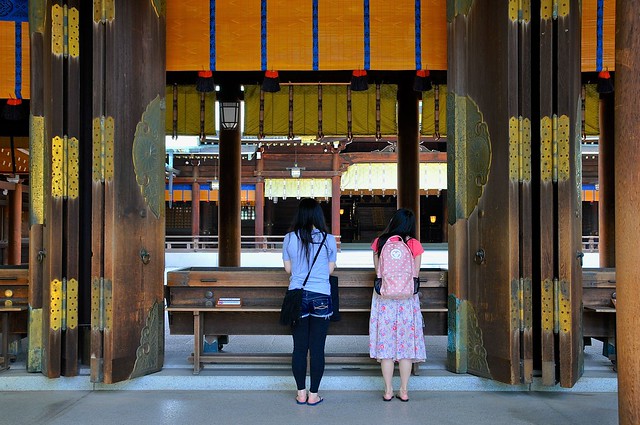 |
Prayer. At a shinto shrine
you toss a few coins into the box, bow twice, clap your hands twice to
gather the spirits, say a silent prayer with your palms pressed
together, then finish with a final bow.
|

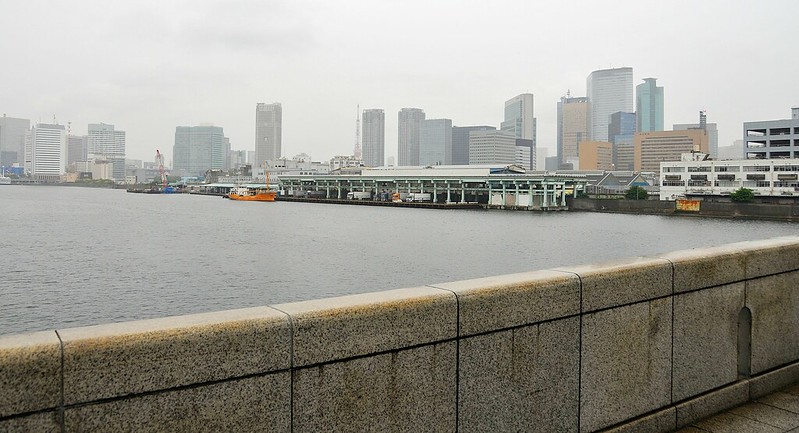

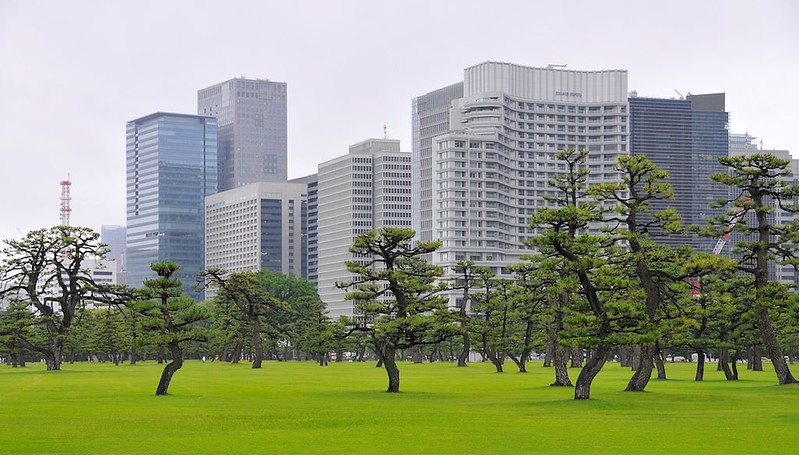
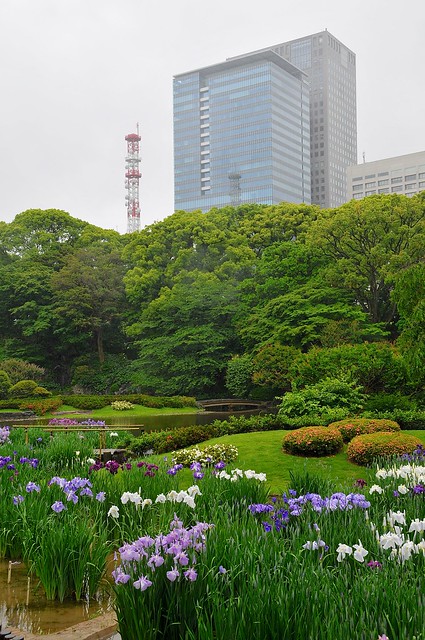


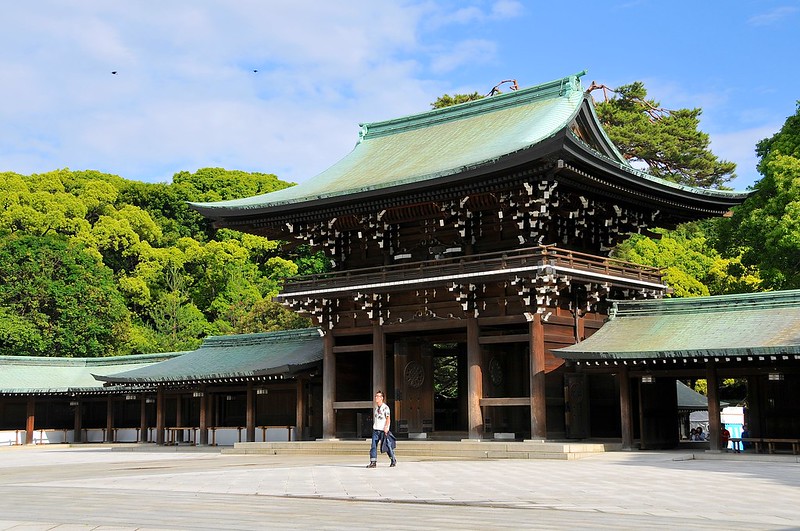
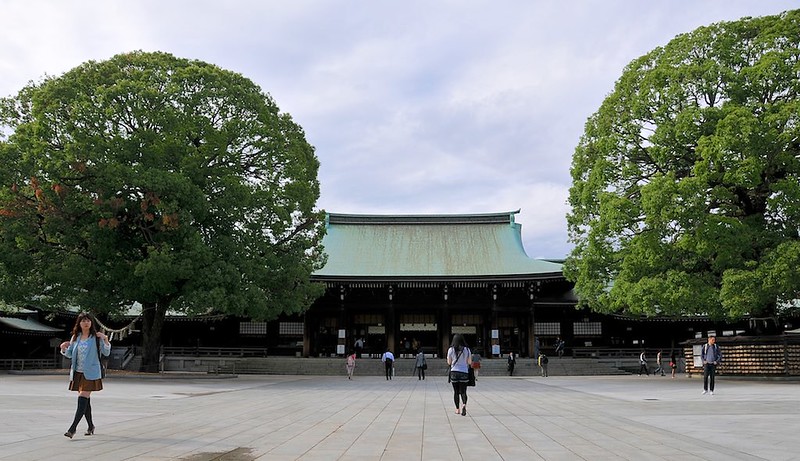

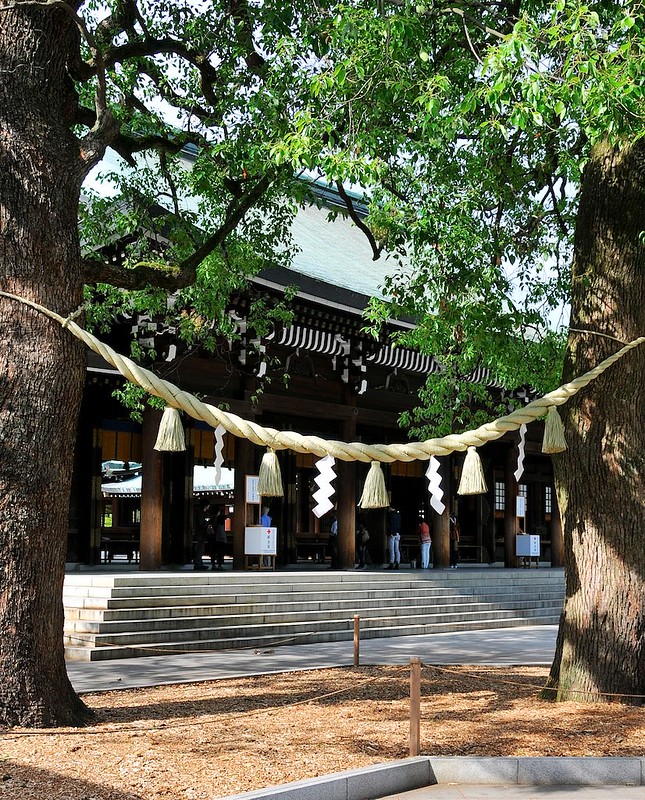
No comments:
Post a Comment